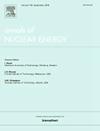A composite fault diagnosis method for nuclear power plant rotor system based on symmetrized dot pattern and residual neural network
IF 1.9
3区 工程技术
Q1 NUCLEAR SCIENCE & TECHNOLOGY
引用次数: 0
Abstract
Composite faults caused by coupling different types of faults increase the complexity of fault diagnosis of the rotor system, which seriously threatens the safety and economy of nuclear power plants (NPPs). In order to accurately identify composite faults in the rotor system, a fault diagnosis method based on symmetrized dot pattern and residual neural networks is proposed. First, multiple sensors are used to collect vibration signals from the rotor system, and these signals are subsequently converted into multi-channel symmetrized dot pattern images to characterize the health status of the rotor system. Secondly, the deep residual neural network is constructed, and the self-attention mechanism is introduced to optimize the network to improve the diagnostic performance of the model. Finally, the residual neural network based on self-attention is used to recognize multi-channel symmetrized dot pattern images to achieve composite fault diagnosis of the rotor system. In the case study, the proposed method is applied to the fault simulation test bench, and performance evaluation is completed based on multiple indicators. The results show that the proposed method can diagnose composite faults of the rotor system with high accuracy, and its diagnostic performance is better than other cutting-edge methods, indicating its potential application value in the composite fault diagnosis task of the NPPs rotor system.
求助全文
约1分钟内获得全文
求助全文
来源期刊

Annals of Nuclear Energy
工程技术-核科学技术
CiteScore
4.30
自引率
21.10%
发文量
632
审稿时长
7.3 months
期刊介绍:
Annals of Nuclear Energy provides an international medium for the communication of original research, ideas and developments in all areas of the field of nuclear energy science and technology. Its scope embraces nuclear fuel reserves, fuel cycles and cost, materials, processing, system and component technology (fission only), design and optimization, direct conversion of nuclear energy sources, environmental control, reactor physics, heat transfer and fluid dynamics, structural analysis, fuel management, future developments, nuclear fuel and safety, nuclear aerosol, neutron physics, computer technology (both software and hardware), risk assessment, radioactive waste disposal and reactor thermal hydraulics. Papers submitted to Annals need to demonstrate a clear link to nuclear power generation/nuclear engineering. Papers which deal with pure nuclear physics, pure health physics, imaging, or attenuation and shielding properties of concretes and various geological materials are not within the scope of the journal. Also, papers that deal with policy or economics are not within the scope of the journal.
 求助内容:
求助内容: 应助结果提醒方式:
应助结果提醒方式:


